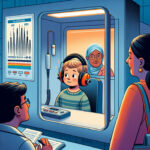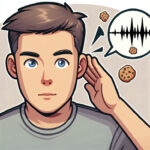Cut Ear Buzzing Using This 3-Second Pinch Method
Sensorineural Audiogram Explained: Interpreting the Results

Understanding the Basics of the Sensorineural Audiogram
Hearing is a complex and vital sense that connects us to the world. When issues arise, understanding the nature and extent of hearing loss is critical. The sensorineural audiogram is a tool used by audiologists to evaluate and diagnose a type of hearing loss known as sensorineural hearing loss (SNHL). SNHL occurs when there is damage to the inner ear or to the nerve pathways from the inner ear to the brain. Unlike other types of hearing loss, SNHL is generally permanent and can significantly affect one's quality of life.
Defining Sensorineural Hearing Loss
Sensorineural hearing loss is the most common type of permanent hearing impairment. It results from damage to the hair cells in the cochlea (the sensory organ for hearing) or the auditory nerve. This damage can stem from a variety of causes, including aging, excessive noise exposure, certain medications, and various health conditions. SNHL can affect the ability to hear quiet sounds, understand speech clearly, especially in noisy environments, and may also cause sounds to be perceived as distorted or muffled.
Components of an Audiogram: Frequencies and Decibels
An audiogram is a graph that displays the softest sounds a person can hear at various frequencies or pitches. Frequencies are measured in Hertz (Hz) and represent the tone's pitch, ranging from low to high. Decibels (dB) measure the intensity or loudness of sound. During the test, an individual's hearing threshold for each frequency is determined and plotted on the audiogram, which helps in identifying the specific characteristics of their hearing loss.
The Role of the Sensorineural Audiogram in Diagnosis
The sensorineural audiogram is not just a test; it's a diagnostic cornerstone for audiologists. It reveals not only the presence of SNHL but also provides invaluable information about its severity and configuration. By graphically representing hearing thresholds across frequencies, the audiogram can pinpoint the frequencies that are most affected and guide the development of a tailored management or treatment plan for the individual.
The Sensorineural Audiogram Test Procedure
Preparing for the Test: What to Expect
Before undergoing a sensorineural audiogram, no special preparation is typically required. However, it's important to avoid exposure to loud noises prior to the test to prevent temporary hearing threshold shifts. During the initial consultation, the audiologist will ask about your medical history, exposure to noise, and any symptoms you're experiencing. It's crucial to share any relevant information that could affect your hearing or the test results.
The Testing Process: How It's Conducted
The sensorineural audiogram is conducted in a sound-treated room or booth to ensure accuracy. You'll wear headphones or earplugs connected to an audiometer, which plays sounds at different frequencies and volumes. You'll indicate when you hear a sound, often by pressing a button. The audiologist will plot these thresholds on the audiogram. Bone conduction testing may also be performed to distinguish between sensorineural and conductive hearing loss.
After the Test: Initial Discussion of Results
Once the test is complete, the audiologist will sit down with you to discuss the initial findings. They'll explain the layout of the audiogram and provide a preliminary interpretation of your hearing thresholds. This conversation is an opportunity to ask questions and express concerns. The audiologist will also outline the next steps, which may include further testing or discussing potential treatment options.
Interpreting Sensorineural Audiogram Results
Reading the Audiogram: Symbols and Lines
An audiogram features a grid with frequency (pitch) on the horizontal axis and intensity (loudness) on the vertical axis. Symbols represent the softest sounds heard at each frequency in each ear, typically an "O" for the right ear and an "X" for the left ear. A series of these symbols forms lines that illustrate the individual's hearing thresholds across frequencies, giving a visual representation of their hearing profile.
Determining the Degree of Hearing Loss
The degree of hearing loss is categorized based on the average of hearing thresholds at key speech frequencies (500Hz, 1kHz, 2kHz, and 4kHz). The scale ranges from normal (-10 to 25 dB HL) to profound (91 dB HL and above). Audiologists use this scale to classify the severity of hearing loss, which is essential for recommending appropriate interventions and predicting communication impact.
Recognizing Patterns of Sensorineural Hearing Loss
Patterns on a sensorineural audiogram can indicate specific types of SNHL. A sloping pattern, for instance, shows better hearing at low frequencies and poorer hearing at high frequencies, often associated with noise-induced hearing loss or presbycusis (age-related hearing loss). A flat loss indicates similar hearing levels across frequencies. Recognizing these patterns helps in identifying potential causes and determining the best course of action.
Understanding Frequency and Pitch on the Audiogram
High-Frequency vs. Low-Frequency Hearing Loss
High-frequency hearing loss is common in SNHL and can significantly affect speech understanding, as consonants, which are high-pitched, become difficult to discern. Low-frequency hearing loss, though less common, can also impact speech comprehension and the ability to hear vowel sounds. The audiogram's ability to differentiate between these losses is critical for customizing treatment strategies.
The Significance of Speech Frequencies in Sensorineural Hearing Loss
Speech frequencies, typically between 500Hz and 4kHz, are crucial for understanding conversation. On the audiogram, the area representing these frequencies is often referred to as the "speech banana" due to its shape. Sensorineural hearing loss within this range can significantly impair communication, underscoring the importance of accurate diagnosis and effective management.
The Importance of Decibel Levels in Sensorineural Audiograms
What Decibel Levels Tell Us
Decibel levels on an audiogram indicate the softest sounds a person can hear. They tell us not only the severity of hearing loss but also provide insight into the individual's listening abilities in various settings. Thresholds at or above 20 dB HL may indicate difficulty hearing soft sounds or speech, particularly in the presence of background noise.
The Range of Hearing Loss: Mild to Profound
Hearing loss is categorized by the average decibel level at which sounds become audible. Mild hearing loss ranges from 26 to 40 dB, moderate from 41 to 55 dB, moderately severe from 56 to 70 dB, severe from 71 to 90 dB, and profound at 91 dB and above. Each level has specific implications for communication and daily functioning, guiding intervention strategies.
Decibel Thresholds and Daily Life Implications
Understanding decibel thresholds is essential as they relate directly to real-world listening experiences. For example, someone with a moderate hearing loss may struggle to hear conversational speech, which is typically around 50 dB. This can lead to challenges in social situations, work environments, and other daily activities, highlighting the need for effective management and accommodations.
Bilateral and Unilateral Sensorineural Hearing Loss on the Audiogram
Interpreting Asymmetrical Hearing Loss
Asymmetrical hearing loss, where hearing ability differs between ears, can be depicted on an audiogram. It may suggest a variety of causes, from noise exposure to more serious medical conditions. Asymmetry warrants further investigation to determine the underlying cause and to tailor treatment accordingly.
The Implications of Symmetrical Hearing Loss
When hearing loss is symmetrical, it affects both ears similarly. This pattern is often seen in age-related hearing loss and may suggest a genetic predisposition or exposure to shared environmental factors. Symmetrical hearing loss can simplify certain aspects of treatment, like the fitting of hearing aids, since both ears typically have similar requirements.
Next Steps After a Sensorineural Audiogram Diagnosis
Treatment Options for Sensorineural Hearing Loss
Though SNHL is generally irreversible, there are several treatment options. Hearing aids are the most common, amplifying sounds to make them more accessible. The audiologist will consider the audiogram results, lifestyle, and personal preferences when recommending a specific type or style of hearing aid. Other options may include assistive listening devices or strategies to improve communication.
The Role of Hearing Aids and Assistive Devices
Hearing aids are sophisticated devices that not only amplify sounds but also can be programmed to match an individual's specific hearing profile as revealed by the audiogram. Assistive listening devices, such as amplified telephones or TV listening systems, can complement hearing aids by targeting specific listening scenarios, thereby enhancing overall hearing ability.
When to Consider Cochlear Implants
Cochlear implants may be considered for individuals with severe to profound SNHL who do not benefit sufficiently from hearing aids. These electronic devices bypass damaged hair cells in the cochlea and directly stimulate the auditory nerve, providing the sensation of sound. The decision to pursue a cochlear implant involves thorough evaluation, including audiogram results, and discussions about expectations and outcomes.
Living with Sensorineural Hearing Loss
Adapting to Life with Hearing Impairment
Adapting to life with hearing loss involves more than just using hearing aids or other devices. It often requires learning new strategies for communication, such as facing speakers or using visual cues. Rehabilitation programs, including auditory training and speechreading, can also be beneficial. Staying informed about your condition and proactive in its management can greatly enhance quality of life.
Support Resources and Rehabilitation
Support resources are invaluable for individuals with sensorineural hearing loss. This includes patient education, counseling, and connecting with others through support groups or online communities. Rehabilitation services, such as speech therapy or auditory training, help individuals make the most of their residual hearing and improve communication skills.
The Future of Sensorineural Hearing Loss Management
The management of sensorineural hearing loss is an evolving field. Ongoing research and technological advancements continue to improve the effectiveness of hearing aids and cochlear implants. Additionally, gene therapy and regenerative medicine are emerging areas that hold promise for potentially restoring hearing in the future. Staying abreast of these developments is important for anyone affected by SNHL.

Laura Henderson is a health enthusiast and has been interested in healthy and natural methods of eliminating tinnitus and restoring natural hearing for many years.











